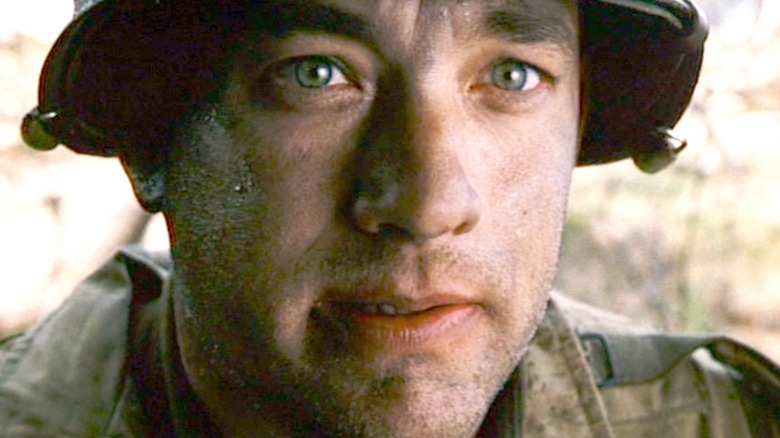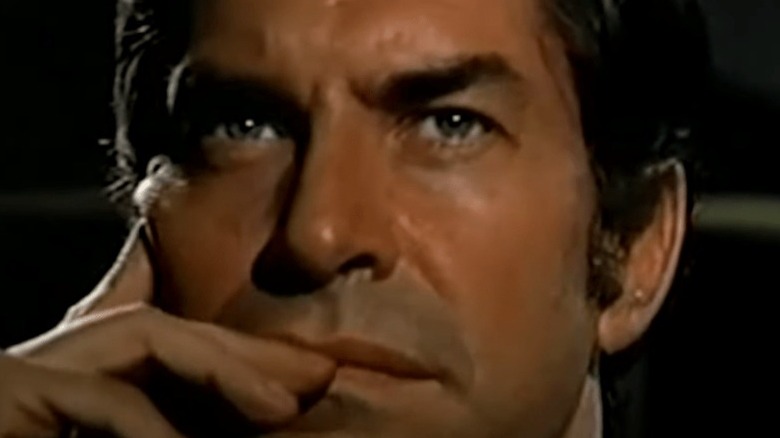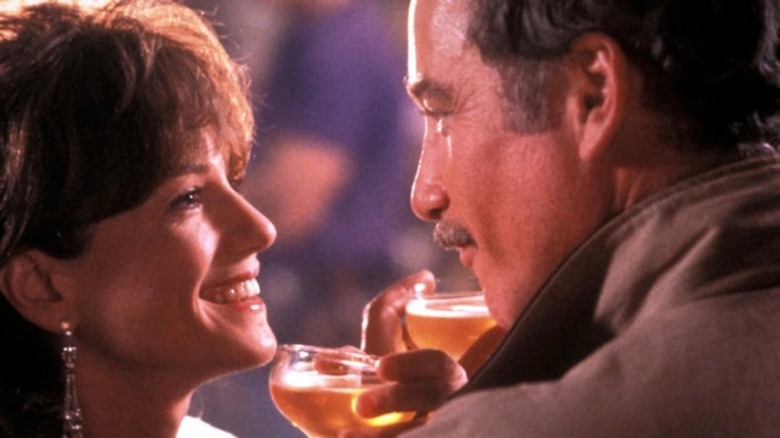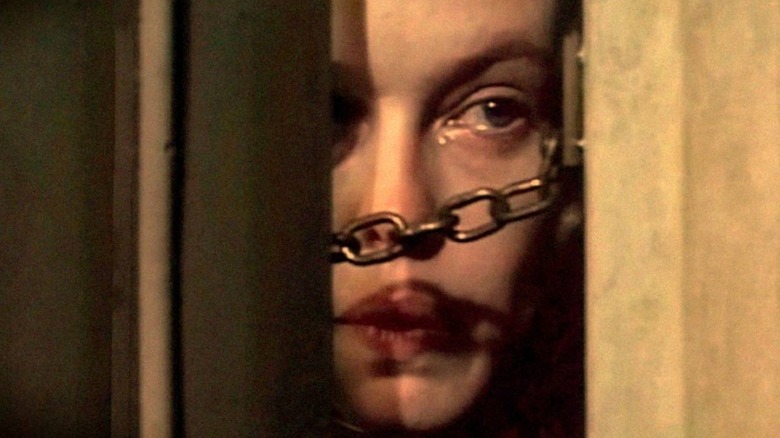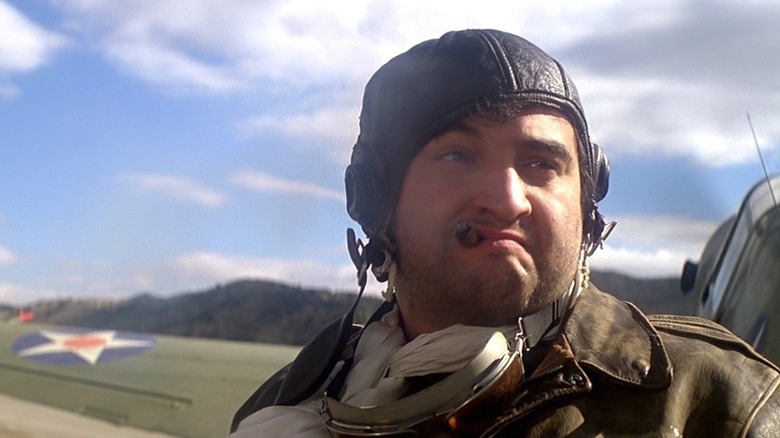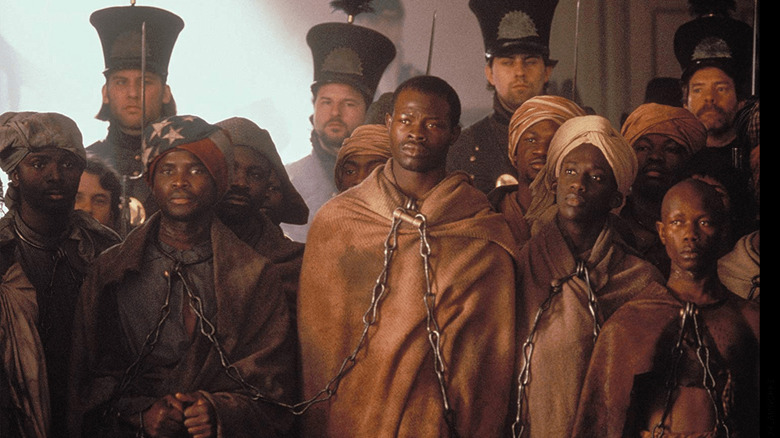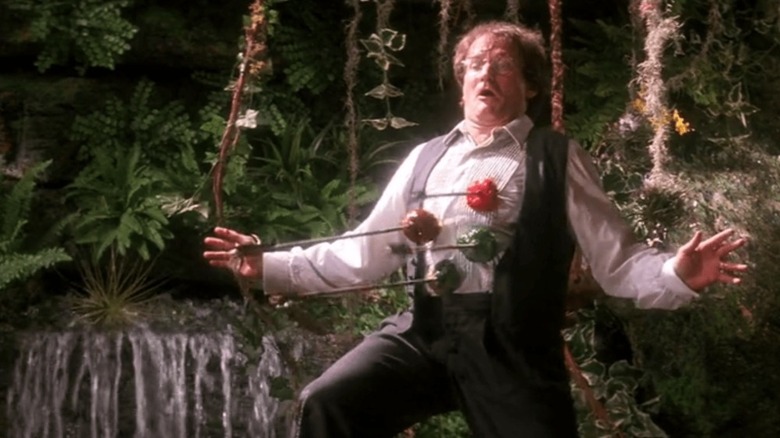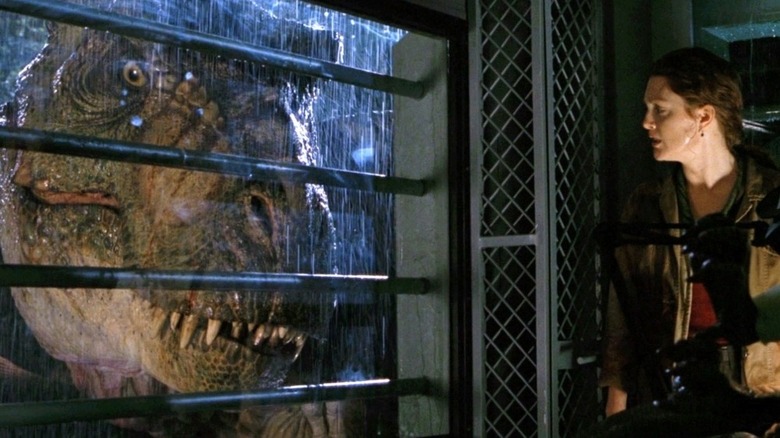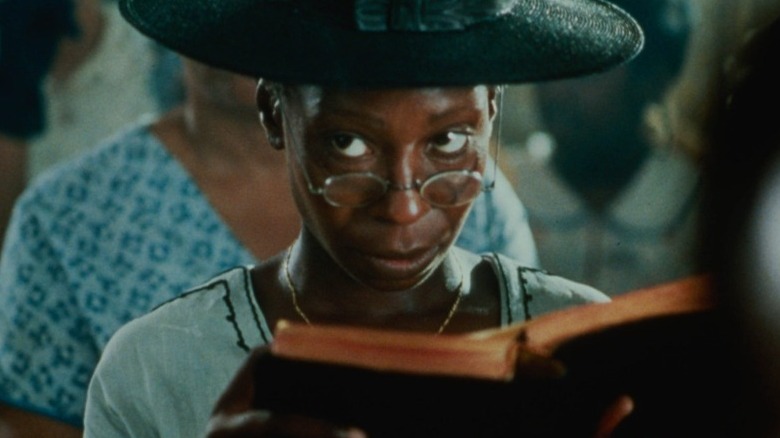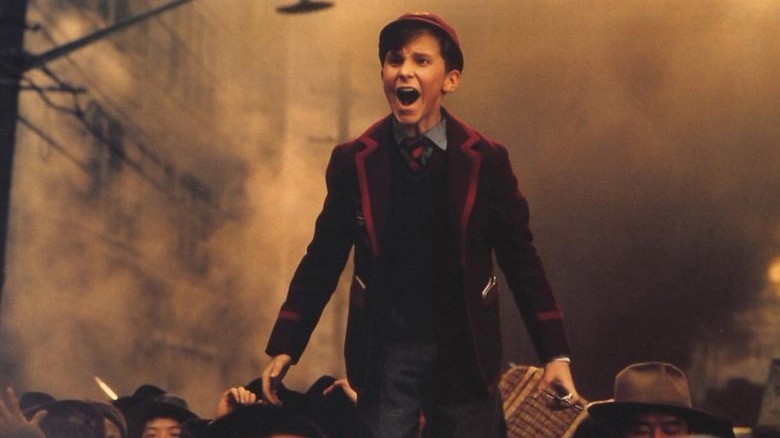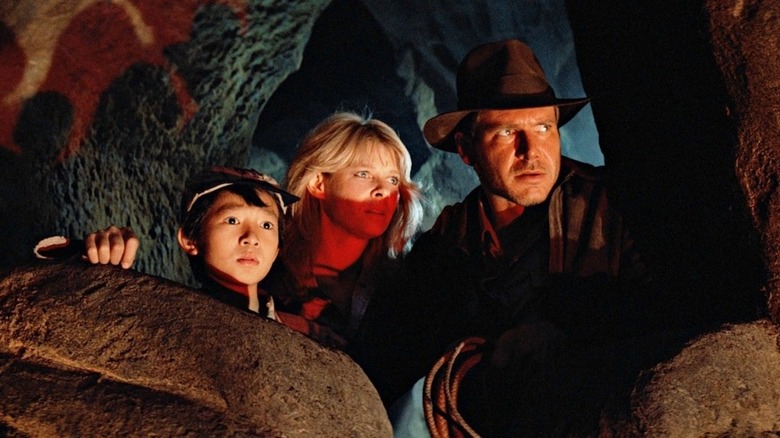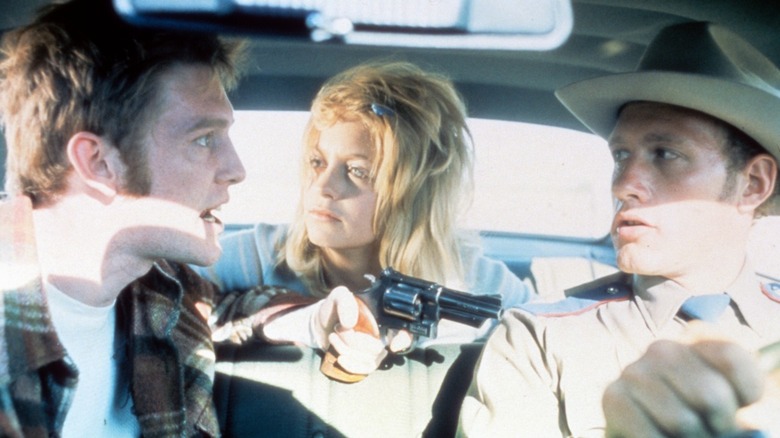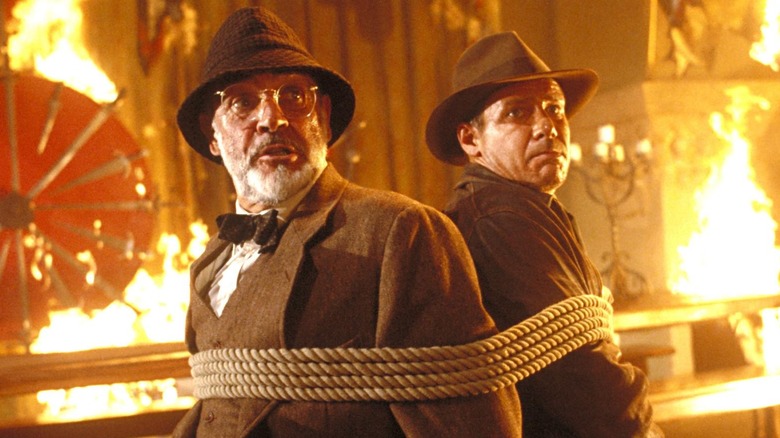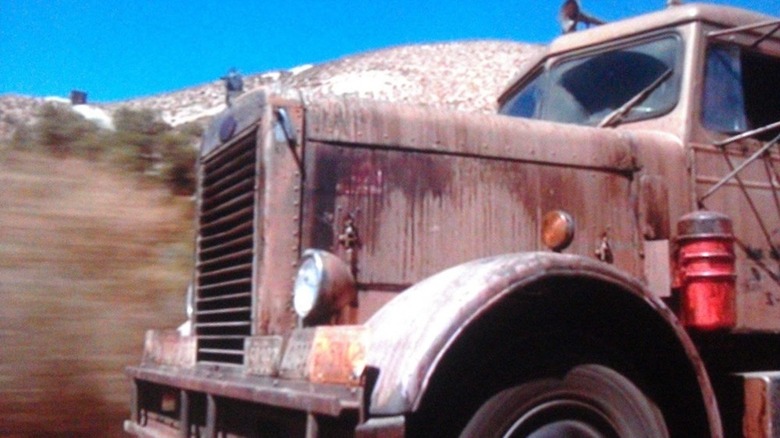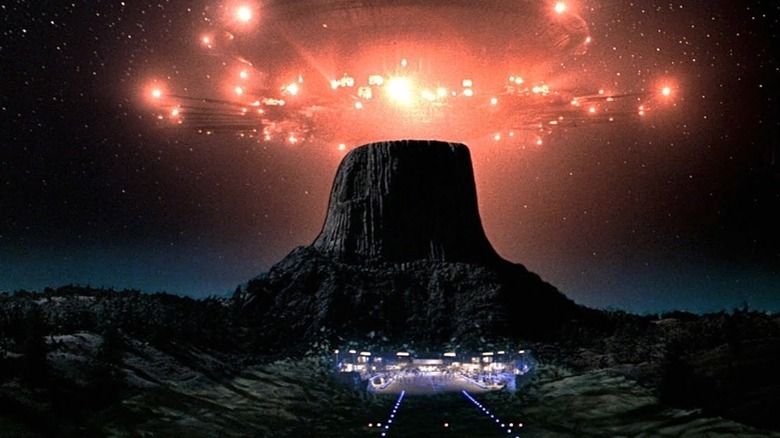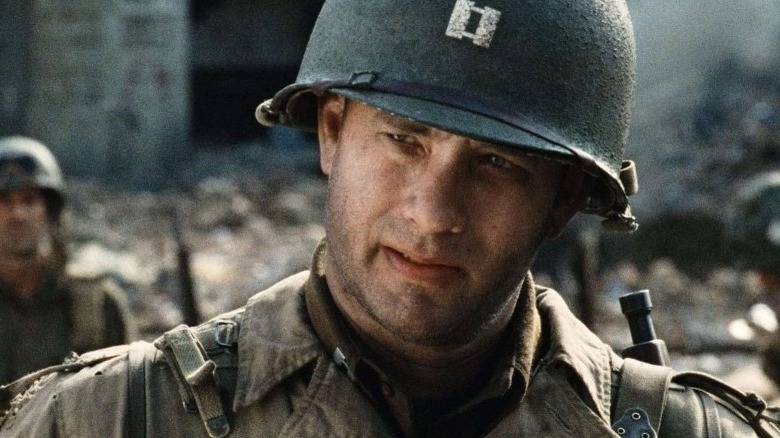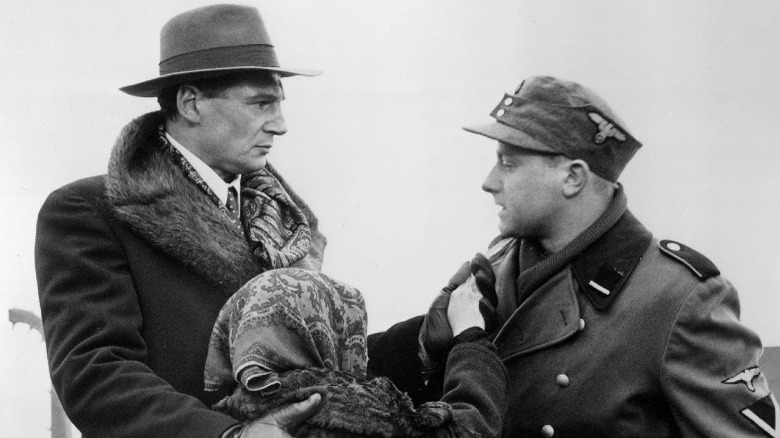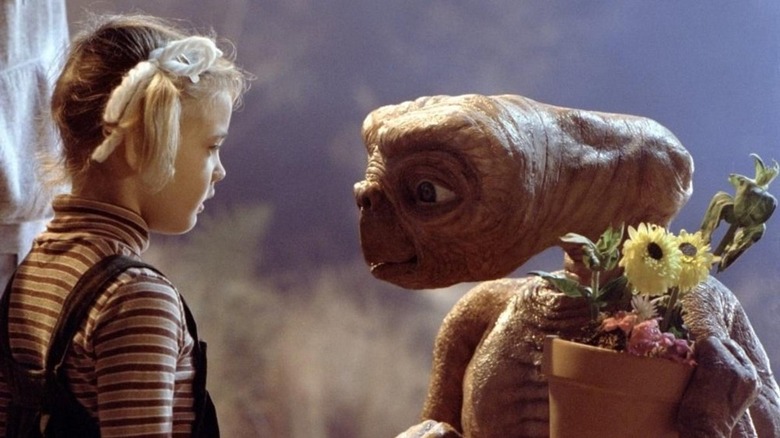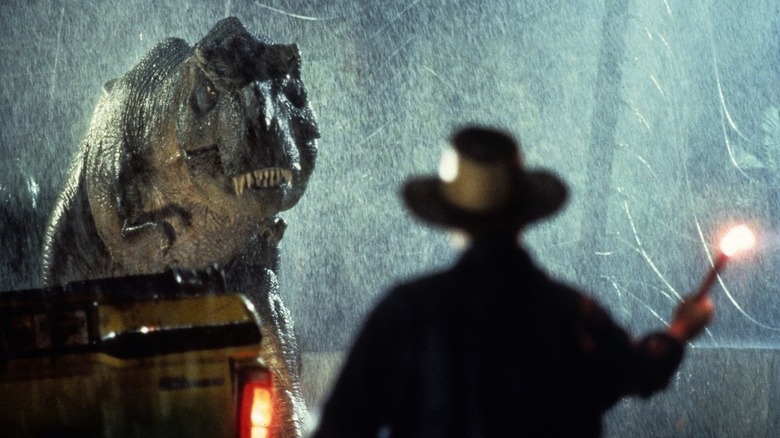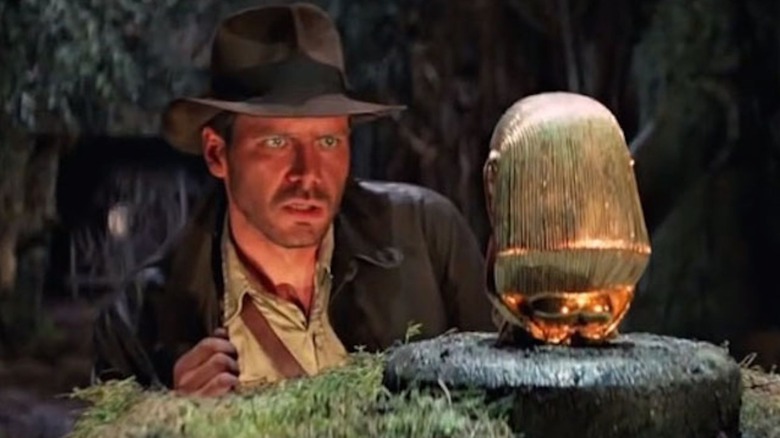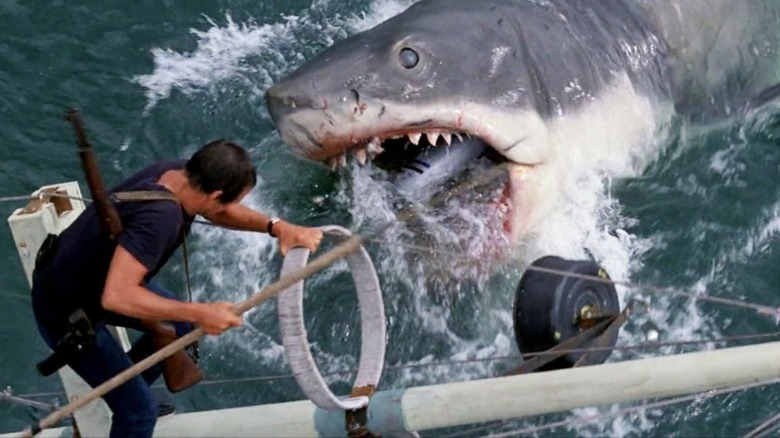20th Century Spielberg Movies Ranked Worst To Best
Steven Spielberg may not be your favorite film director, but the odds are quite good that you love at least one or five of his movies. He's also the kind of filmmaker whose talents are undeniable — go ahead, try to deny them. You can't! His work may be too schmaltzy or pure for some, but Spielberg's innate ability and craftsmanship are present in every film he makes, from his very first features to his most recent. It makes ranking his work, already a subjective minefield, a bit more challenging, as even his "worst" efforts reveal an effortless mastery of the form.
But we're doing it anyway.
Below are the 20 films Spielberg directed in the 20th century — and no, "Poltergeist" is not among them, you Tobe Hooper-hating conspiracy theorists — ranked from lesser to greater for your reading pleasure and guaranteed agreement. We're including his three made-for-TV films as well, both because they're technically movies and also because 20 is so much more appealing than 17. Enjoy!
20. Savage
A television reporter dedicated to delivering the truth to viewers is stymied when a massive story lands in his lap with strings attached. It involves the infidelity of a Supreme Court Justice, but the stakes of the story ramp even higher when the subject of the judge's fling is murdered.
Spielberg's third and final made-for-television movie is by far his least engaging, and it's clear that he was taking filler to finish out his seven-year contract with Universal. Rather than see the film as a regression on Spielberg's part, though, its faults lay most clearly with the script as dramatic beats fail to satisfy and exposition fails to end. (Fine, it obviously ends, but it takes its sweet time getting there.) Still, Spielberg's direction works to keep things moving, and you'll find few faults with the performances by Martin Landau and Louise Latham.
19. Always
Pete, a daredevil service pilot who tries to balance his carefree and risky lifestyle with the needs of the woman he loves, faces an even greater challenge after he dies in a fiery explosion. He's tasked with being a guardian angel of sorts for another pilot — a man who happens to be falling for the love of Pete's life.
It's always strange when all of the ingredients come together but a film still falls flat. "Always" comes from a masterful director, is adapted from a Dalton Trumbo screenplay, and features a stellar cast including Richard Dreyfuss, Holly Hunter, John Goodman, and Audrey Hepburn (in her final film role), but very little of it works. Spielberg is no stranger to sappy emotions, but he uses them best when they're in service of something else — the interspecies friendship between a boy and an alien, or the guilt felt by Oskar Schindler. Here, the sap is the point, and it implodes on impact.
A lack of chemistry between Hunter and her suitors doesn't help (curiously, Hunter and Dreyfuss would reunite two years later for "Once Around" and display a far better connection), and the undead romance stumbles (a formula that "Ghost" would nail the following year). Pete's voice of "inspiration" feels a lot closer to mind control, which can't help but lessen the intended effects up to and including the end, when he tells her "I am releasing you." She needs to move on, but the film plays it like she also needs his permission to do so. She does not.
18. Something Evil
A couple and their family move from the hustle and bustle of New York City to the rural outskirts of Pennsylvania, but the house they've chosen is infested with a supernatural presence. The entity soon possesses one of their children and reveals itself to be a real pain in the butt.
As with the other TV film above, this early '70s horror effort — a genre that's still a rarity for the director — lacks any real passion or interest from Spielberg. His directorial chops are on full display, and some creepy sequences manage to provide atmosphere and minor tension, but the script's generic nature leaves it all feeling like a cheap cash-in on the success of William Peter Blatty's bestselling novel from the year before, "The Exorcist."
17. 1941
It has been one week since Pearl Harbor fell, and west coast Americans aren't doing too well. That anxiety kicks into overdrive when an enemy sub is spotted offshore and planes buzzing over Los Angeles are mistaken for Japanese aircraft. Chaos and incompetence reign.
While Spielberg's first big misfire has found a re-evaluation in some corners recently, it remains an expensive miscalculation. The cast is absolute aces (Nancy Allen, Dan Aykroyd, Ned Beatty, John Belushi, John Candy, Toshiro Mifune, Warren Oates, Mickey Rourke, Wendie Jo Sperber, Robert Stack, Treat Williams, and on and on — seriously, I could keep going), and both the production design and miniature work are top shelf.
But, good gravy, is "1941" seriously unfunny for a comedy. Spielberg fills the screen with chaos — loud screaming, explosions, violence played for laughs — resulting in a movie that's far too cluttered for any single character thread to really stand out. You can picture writers Robert Zemeckis and Bob Gale chuckling behind their typewriters, but Spielberg just can't translate this chaos to the screen.
16. Amistad
A Spanish ship transporting Africans earmarked as slaves is rocked by a revolt, but when the men attempt to sail back to their homeland they instead wind up as prisoners in the United States. A lawyer takes the case and argues for their freedom before the Supreme Court.
Like "Schindler's List," "Amistad" explores a true historical footnote set against a much larger story about man's inhumanity. Unlike that earlier film, though — and it feels wrong to say this — this movie is surprisingly dull and tiresome. The cast is as impressive as you'd hope (Matthew McConaughey, Morgan Freeman, Anthony Hopkins, David Paymer, and more), but Djimon Hounsou aside, they're unable to lift the material and hold the viewer's attention. "Amistad" is 40 minutes shorter than "Schindler's List," yet feels an hour longer. The film is so intent on educating that it fails to engage. The cast, production design, themes, and Spielberg's steady hand prevent it from being a bad film, but you'd be hard-pressed to find anyone lining up for a rewatch.
15. Hook
Peter Pan is all grown up and enjoying the normal drudgeries of life, but when Captain Hook kidnaps his children, he's forced to return to Neverland to save them. Can he reconnect with his own inner child, or are his kids doomed to be croc food?
Is "Hook" the most divisive Spielberg film? Possibly. Those who enjoy and appreciate its on-the-nose emotional beats, inconsistent silliness, and maudlin ruminations by a middle-aged divorced dad certainly seem to love it. Others despise it for those reasons and more.
Its placement on this list reveals where it falls for me, which is somewhere south of the middle. Spielberg's directorial talents are undeniable, the fanciful production design feels beautifully dreamlike, and it's difficult to argue with the likes of Robin Williams, Julia Roberts, Dustin Hoffman, and Bob Hoskins fully reveling in the childlike wonder of it all. There's an argument to be made that the film's appeal is stronger the younger you see it, but even if that's true, shouldn't its theme — a cynical and sad adult rediscovers his childish self — carry over to similarly jaded adult viewers? Because it doesn't. It really, really doesn't.
14. The Lost World: Jurassic Park
Surprise! Those sneaky bastards behind the original theme park had a second island up and running, with additional dinosaur shenanigans afoot. I sure hope the reptilian beasties don't escape and cause more chaos.
It's undeniable that "The Lost World: Jurassic Park" pales beside its predecessor. Not even Spielberg would pretend otherwise. It's sillier, the characters are less endearing, CG is favored more unevenly over practical effects, and it never manages anything remotely resembling the wonder and awe unleashed by the first film. Jeff Goldblum's promotion to lead character after the first film's more ensemble-like approach isn't without merits, but the parental themes feel far too forced. And don't get me started on that gymnastics scene. Still, all of that said, it's a Spielberg film about dinosaurs on the attack, meaning it is highly watchable, B-movie entertainment.
The man knows how to craft a set-piece, and they outshine everything around them, including both cast and script. The raptors stalking human prey through tall grass? Terrifying and suspenseful. The dual T-Rex dinosaurs attacking as part of their own rescue mission? Thrilling and cool. The sight of a T-Rex roaming and rampaging through downtown San Diego? Big, silly fun that also serves as a nod to stop-motion creature features from decades past. This is popcorn entertainment that relies almost exclusively on Spielberg's skill, while missing most of his magic.
13. The Color Purple
Celie's life is filled with heartache and pain, but she learns to hope for the best. It's a long and devastating road, though, as abuse, sexual assault, racism, and other cruelties block her path towards both happiness and a reunion with her sister.
Alice Walker's beloved and bestselling novel about 40 years in the life of a Black woman might not seem like a natural fit for the white, male Spielberg, but he made it anyway to both acclaim and criticism. While "The Color Purple" seems disconnected from the man's early filmography, and cynics claim it was little more than an Oscar bid, a broader look at Spielberg's work reveals that it fits comfortably with his empathetic interests.
The film marks a clear dividing line in Spielberg's directorial career. It's his first pure drama, and even without showy visual effects and genre trappings, his love of people and character shines through. Of course, that's still a struggle, as this is a dark film filled with abuse and seemingly endless heartache. It's a long haul getting to the "happy" ending, so much so that it's one of only a few Spielberg films I've only seen once. The misery is just so much of the journey — too much, in my own subjective opinion — and the celebratory resolution doesn't quite feel triumphant enough.
Happily, the cast is absolutely magnificent here, led by a young Whoopi Goldberg. Add in a terrifying Danny Glover, a devastating Oprah Winfrey, and others, and you have a prestige tale that's unavoidably effective in conveying its themes of misery and resilience.
12. Empire of the Sun
A young British boy, separated from his parents as Shanghai falls to the Japanese during World War II, comes of age against his harsh new reality. Innocence is lost in the blink of an eye — and in the flash of an atomic bomb.
While initially intended as a directorial vehicle for the legendary David Lean, Spielberg came aboard to adapt J.G. Ballard's semi-autobiographical novel, as the pull of its themes was too hard to resist. Family, both real ones and those forged from whoever is available, plays a large role here, as young Jamie befriends adult thieves, a Japanese teen, and others on the city streets and in an internment camp. The passing of years sees the boy become an older, wiser version of himself as he comes to recognize both his own sins and those belonging to humanity as a whole.
Christian Bale makes his feature debut here, and gives a singular performance capturing the joy, heartache, and the utter resiliency of youth. It's his heart and malleable spirit that carries the film through its (perhaps indulgent) run time. John Williams drops another memorable score, cinematographer Allen Daviau finds beauty and horror through his lens (in what would be the last of his five collaborations with Spielberg), and John Malkovich shines as a morally bankrupt American thief whose "friendship" comes loaded with lessons. It's a beautiful film, albeit one that's maybe too simple and calm for the time investment it asks of its viewers, and leaves you with an appreciation for youth. Younger generations can learn and change far better than the rest of us — we can only hope that they do so.
11. Indiana Jones and the Temple of Doom
Indiana Jones narrowly escapes an assassination attempt in Shanghai only to find himself embroiled in a dangerous new adventure in India. Tasked with finding some stolen stones and abducted children, he sweats his way through one close call after the next.
A prequel to "Raiders of the Lost Ark," "Temple of Doom" sees Spielberg and George Lucas taking their hero into some darker directions (so much so that the MPAA developed the PG-13 rating in response to both this film and "Gremlins"). Grisly meals, Indy under mind control, child slavery, actor Pat Roach in brownface, a shrill love interest guaranteed to leave viewers wishing Marion Ravenwood would show up to punch her in the kisser — this is an all-around grimmer and more grounded adventure.
Still, and as is often the case with Spielberg films, the movie's weaknesses are somewhat muted by the poetry of the man's action set pieces. The opening sequence sees beautifully choreographed mayhem unfold in a fancy club before shifting to some wonderfully over-the-top plane and raft antics. A mine cart chase stuns and delights with its intricate structure and high energy. And, honestly, I will always be a sucker for deadly rope bridge shenanigans. Is it a step down from "Raiders?" For sure. Is it still a darkly fun ride? Absolutely.
10. The Sugarland Express
A recently released ex-con decides to break her husband out of jail so they can reunite with their son. Surprising no one but the couple itself, the plan runs into more than a few snags.
Like "Duel" before it, Spielberg's theatrical feature debut is as impressive an early work as you're likely to find. Simple on its face, the film highlights his talents at telling a story and shaping emotion through visuals. The dialogue is fun and the performances are strong, but Spielberg's use of facial expressions and camera placement reveal a sharp awareness of his craft that eludes most 20-somethings (and even those in their 30s, 40s, 50s, etc.). The confidence is almost breathtaking.
Goldie Hawn headlines as the optimistically deluded young woman, and while sweet and playful at times, her performance is miles removed from the "ditzy blonde" that would become her trademark into the '80s and beyond. Spielberg himself sees the police in pursuit of the fugitives as the film's heroes — a sentiment you can't really disagree with — but Hawn's character breaks our hearts all the same. William Atherton and Ben Johnson are both terrific as the husband and lead cop, respectively, and while much of the film involves conversations inside moving cars, Spielberg also makes time for some impressive stunt work along the way. This is an underseen film that deserves far more attention.
9. Indiana Jones and the Last Crusade
A famous archeologist goes missing while searching for the fabled Holy Grail, and his son sets out to find him. The son? Indiana Jones.
The Nazis are back, baby! After ditching German baddies for the somewhat dour "Temple of Doom," Spielberg and friends knew the best course of action was to pit Indiana Jones against a more recognizable and universally despised nemesis. The result? Epic fun. Of course, the uptick in comedy helps too, as the chemistry between Harrison Ford and Sean Connery and some sharp writing make this arguably the most purely entertaining of the trilogy (we're focused on 20th-century Spielberg, so yeah, I said it). While it succumbs to the need for callbacks and clarifications (here's why he hates snakes! Here's where he got the whip and hat!), the film plants a smile on your face that just won't quit.
There's no shortage of action set pieces either, starting with that opening flashback starring a young River Phoenix and continuing on with castle hijinks, an aerial dogfight, an epic brawl on top of a moving tank, and more. While "Raiders" ends with a brief blast from its holy object, "The Last Crusade" allows an entire set piece to occupy its third act, as heroes and villains alike descend into biblical legend for a sip of water. It's a smartly crafted sequence blending action, integrity, and character into something memorable on which to end the Indiana Jones saga. Forever. Because there were no more movies.
8. Duel
A man on a business trip through the American West is targeted by the driver of a semi-truck. Well, he's assuming there's a driver behind the wheel.
Imagine being a filmmaker with a few movies under your belt, and then imagine sitting down to watch "Duel," and realizing it's the very first film from a 25-year-old upstart named Steve. While made for television, Universal Pictures was so impressed with the suspense-filled results that they had Spielberg shoot a few more scenes so they could release it theatrically in international markets.
The film succeeds in part by approaching terror the same way John Carpenter would with "Halloween," by understanding that the unknown is far scarier than a threat we understand and can identify. The truck begins chasing Mann — a subtle touch by writer Richard Matheson — after a minor interaction on the highway, but we never really see the driver. Instead, it's as if this metal monster is pursuing Mann of its own accord, fueled by some unknown karmic motivation to remind the poor guy that the only guarantee in this universe is chaos. Dennis Weaver does great work as an average Joe pushed to the edge, and the end will leave you right there with him.
7. Close Encounters of the Third Kind
An average joe is buzzed by a UFO and sees his normal life take a backseat to a strange new fascination. Something is pulling him across the country, and what's waiting for him just might change the world.
Spielberg's exploration of the UFO phenomenon leaves some viewers cold with its pacing, but it remains a flat-out masterpiece. It's a film about wonder and the unknown, and its focus on goofy little Richard Dreyfuss allows his everyman to be us — we're amazed, confused, thrilled, and pushed to the brink alongside him. His moments of joy are especially contagious, as Dreyfuss sells the elation vividly. There are plenty of visual effects and one hell of a spectacle for a finale, but "Close Encounters" feels more often than not like a coming-of-age tale for humanity itself.
As a horror fan, I'd be remiss in not mentioning the tension and terror that Spielberg creates during little Barry's abduction. He and cinematographer Vilmos Zsigmond deliver a truly frightening set piece as lights invade the house and a desperate mother tries in vain to hold onto her child. It's a short, sharp masterclass in making cinema that unsettles.
6. Saving Private Ryan
The landing at Normandy leaves the beach bathed in blood, but for some of the servicemen who survive that day an even greater challenge awaits. One small unit is tasked with finding a soldier whose only brothers have been killed in action.
Spielberg's final film of the 20th century is a war epic about men on a mission and the sacrifices they make for one another. This story is a specific one, but its characters are also stand-ins for the 400,000 US soldiers who gave their lives fighting for the rest of us. The film walks the line between the epic and the intimate, moving viewers from nerve-shredding battle scenes to heart-stopping moments of cowardice and bravery. The opening beach landing is an all-time great when it comes to bone-shaking battle scenes on film, and the combination of tension and dread as one soldier cowers in fear as his comrade is being killed will stick with you for days.
Tom Hanks leads a stellar cast through moments both harrowing and rewarding, and their journey thrills like few war tales do. But yes, were it not for the embarrassingly bad coda with an elderly Ryan whining to his family about being a good man, "Saving Private Ryan" would have easily claimed the number five spot below.
5. Schindler's List
An industrialist set to profit from the German occupation of Poland instead finds his guilt growing as he bears witness to Nazi cruelties and victimized Jews. He comes to a brave decision that threatens both his livelihood and his life.
Any filmmaker would kill for just one of them, but 1993 saw the release of both Spielberg's Academy Award-winner and his mega-blockbuster, "Jurassic Park." No wonder he took the next four years off. "Schindler's List" was a gamble across the board, as its serious subject matter, R-rating, three-hour-plus running time, and black and white presentation hardly scream box-office success, but its brilliance and emotional effect saw it earn back about 15 times its budget.
"Schindler's List" is an impeccably crafted drama that offers an unflinching look at the horrors of WWII, and Oskar Schindler's journey is one of a man discovering the true value of wealth and the importance of empathy. There's value to viewers, too, in seeing the power of one person's choices, a lesson they'll ideally carry out into the world. It might surprise you, but it turns out one of Liam Neeson's particular skills is the ability to make you cry.
4. E.T. the Extra-Terrestrial
A boy. A wrinkly leather sack with a penchant for poking. A shared love of candy. Some friendships are life-changing and worth traveling millions of miles for.
My first viewing of this film was as part of a double feature with "Conan the Barbarian." The R-rated "Conan the Barbarian." I recall loving Spielberg's film, but the bigger deal that day was my dad yanking my sister and I out of the theater while Conan fights the topless witch by the fireplace. But "E.T." won my little heart again soon enough, as I returned to see it twice more in theaters, and when I revisited it again after a long while I was pleasantly surprised to discover it's still every bit as funny, warm, and heartbreaking to my adult eyes.
Family films, especially ones first viewed as a child, don't always maintain their power upon later viewings, but Spielberg's craftsmanship and attention to character ensure the magic of "E.T." survives well past puberty. Its themes of friendship, compassion, and family are so well presented, and paired with such engaging genre trappings, that it will still leave your heart racing and your eyes watering. The kids and the alien are the stars, but save some love for both Dee Wallace and Peter Coyote, who offer warmth from their own unique adult perspectives.
3. Jurassic Park
Life finds a way — as does corporate greed when a billionaire finances the technology to clone dinosaurs in order to build a theme park where folks can come see the impossible (and the deadly).
Like "Jaws" two decades earlier, "Jurassic Park" saw Spielberg once again redefine the blockbuster era. It earned nearly a billion dollars on its initial run (a re-release pushed it over that hump, making it the oldest film to reach that box office milestone), received critical acclaim, and kicked off a six-film franchise that's still going strong. A great cast that includes Sam Neill, Laura Dern, Jeff Goldblum, and Richard Attenborough, combined with a classic John Williams score and a smartly thrilling script (adapted from Michael Crichton's bestseller), create a family-friendly-ish adventure that never disappoints on rewatches.
One of the big keys to its success and staying power is the high quality and dual variety of its special effects. The number crunchers at ILM delivered some stunning digital effects, bringing dinosaurs to life in such epic fashion that viewers feel almost the same sense of awe as the characters on the screen. The effects still hold up, too, surpassing the visual quality of more than a few CGI efforts produced in the three decades since its release. But CG alone wouldn't cut it, and Spielberg wisely brought in genius Stan Winston to create practical creatures as well, giving a tangible presence to the dinosaurs. "Jurassic Park" is giant, beautifully crafted fun.
2. Raiders of the Lost Ark
A college professor beloved by his (female) students prefers to spend his free time on spelunking adventures that threaten his life but not his tenure. His latest quest sees him reuniting with an old flame, facing off against Nazis and snakes, and finding the fabled Ark of the Covenant.
This first Indiana Jones adventure remains one of the most purely entertaining films in existence. A big, globe-trotting romp in the spirit of old serials and pulp magazine yarns, it's grounded by Harrison Ford's indelible performance as the wily Dr. Jones, whose everyman appeal set the stage for numerous big screen heroes that followed. It's as rousing and fun a ride as you're likely to find, from its close-call opening set piece through to its final showcase of action, suspense, and ILM-crafted magic.
Spielberg typically excels at blending action sequences with personality and humor, and "Raiders of the Lost Ark" is still one of the finest examples of that cinematic concoction. John Williams' iconic score helps hold it all together, as we're carried around the world, watching the film deliver one "stand up and cheer" beat after another. There's something pure about this movie, a big spectacle that teases past adventures and mysteries before it became fashionable for blockbusters to leave no dot unconnected. Jones has had quite the life before "Raiders," and Spielberg feels no pressure to share every last detail with audiences (well, at least not until later sequels started unnecessarily filling in those gaps).
1. Jaws
The start of summer brings tourists to the small island community of Amity for fun and sun, but an unexpected visitor arrives with plans of its own. All that's standing between a shark and its human buffet is a sheriff who's afraid of water, a marine biologist who wants to keep the predator alive, a fisherman with a grudge against sharks, and a mayor with only the town's best interests at heart.
The top two spots on this list can arguably be swapped back and forth, but while I love both, "Jaws" is the only correct number one. The film is rightfully credited as the first summer blockbuster, an event that changed the theatrical experience as we know it, but while it delivers big thrills and set pieces it's also a masterclass in intimacy and character. Brody at the dinner table with his son, a grieving woman taking out her loss on the sheriff's cheek, the three men comparing scars in the boat's galley — any prestige film would kill for such moments, and here they're part of a killer shark flick.
Every aspect of the film clicks but one, and in lesser hands could have sunk the entire film: At no point does the mechanical shark look like a living creature. Our brains recognize that fact, but the film's excellence elsewhere ensures that we just don't care. The "try chumming some of this" scene? The shark looks terribly fake, but we are in awe. Quint getting munched? The shark looks like a malfunctioning toy, but we're horrified by the man's screams. We're still terrified, thrilled, moved, delighted, and entertained by every single moment, no matter how many times we revisit it.
